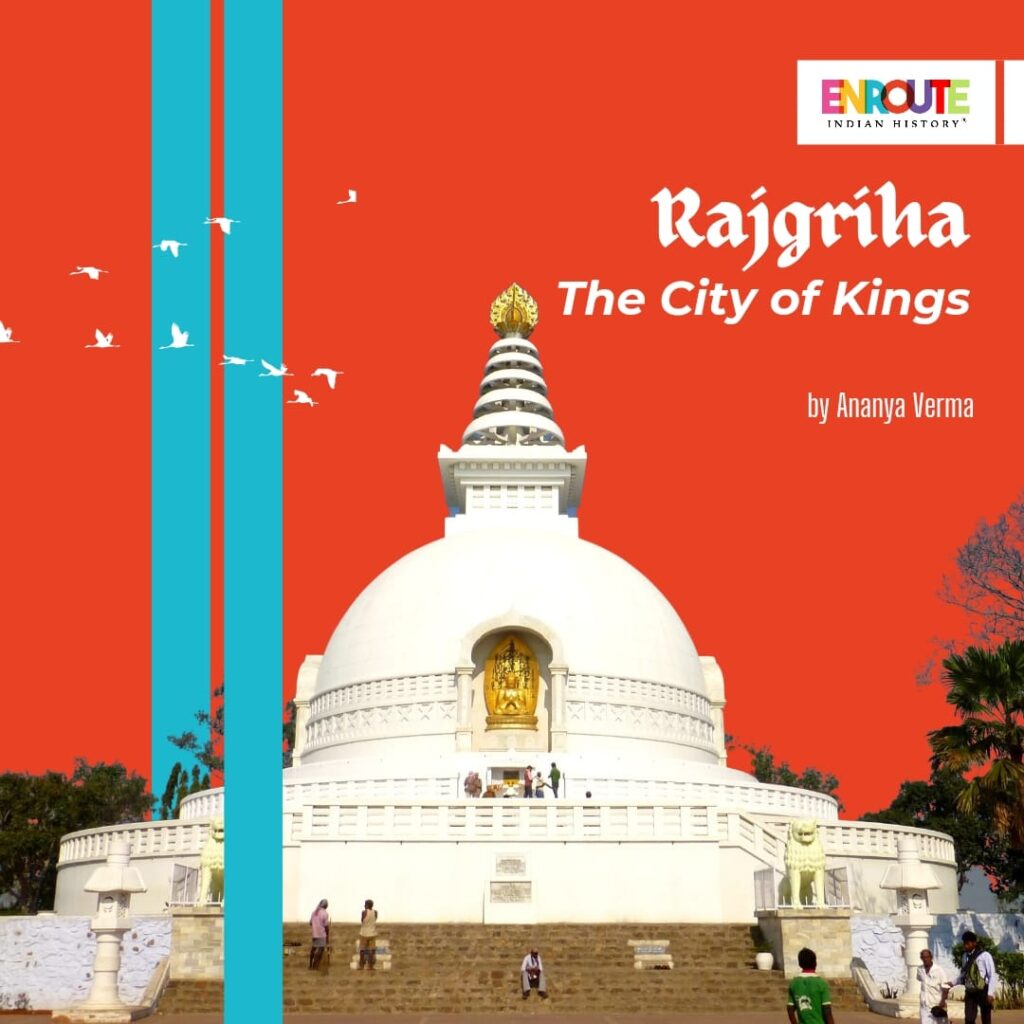
Rajagriha (present-day Rajgir), a city holding a great history is deeply connected with the mighty Mauryan empire. It was the capital of the Magdha Mahajanapada that is believed to have eventually evolved into the pan-Indian Mauryan empire. The city finds its mention in Mahabharata and continues to become an important landmark in Buddhist and Jaina literature. The vicinity of Rajagriha was also home to the historic and contemporary Nalanda University. The study of this city has allowed Indian archeology to understand the pre-destined conditions which would eventually lead to the development of the Mauryan empire.

Rajagriha from early reports of ASI
The key to understanding the importance of Rajagriha is its geographical location. Rajagriha is located 60 miles southeast of Patna, the present capital of Bihar. The city is fortified by the hills of the Barabar range, providing natural protection. Interestingly, the Barabar range is home to the four oldest rock-cut caves of India believed to have been built during the Mauryan empire. The city is also a terminal point in the Dakshinapatha, the trade route connecting the Gangetic planes to the Deccan. The first Buddhist council was held at Rajgiriha to compile and commemorate the teachings of Buddha, after a year of his passing. This tradition of Buddhist councils was continued in the Mauryan empire with the 3rd Buddhist council being taken place in Patliputra under the patronage of Ashoka.
One of the earliest pre-Buddhist connections of Rajagriha is mentioned in Mahabharata. The city is connected to the story of Jarasandha and his clash with the Pandavas. Jarasandha had a boon that allowed him to reattach his limb in case of a loss of a limb during a fight, making it extremely difficult to defeat him. In the epic, a wrestling match takes place between Bhima and Jarasandha, ending in Bhima tearing his body into two parts and throwing them in two different directions to avoid re-attachment. The story is embedded in the folk culture of Rajgir trying to keep the connection to the traditions of ancient India.

Wikipedia Commons: Jarasandha’s Akhara is an ancient historical monument at Rajgir in Bihar, India
It is interesting to highlight that the excavation at Rajagriha has closely underlined the developments in Indian archeology. The site has been excavated from 1812 till much later in the 20th century. The earlier excavations, especially during the colonial period, focused on findings to supplement the data of the Buddhist literature and the accounts of Chinese pilgrims.

Wikipedia Commoms: Vulture Peak, Rajgir, India. The small structure (small room) designates the place where Buddha used to stay when living on Vulture Peak. This picture was taken from another, nearby mountain. The valley is where the outskirts of the old city of Rajagaha used to be.
One of the most discussed archeological phenomena is the fortification at Rajagriha. Although being located in a valley, the capital was naturally fortified but there have been finding of walls that were believed to have been constructed by the Magdhan rulers. The mapping of these walls has also improved with time. In the ASI report of 1951 under Amalananda Ghosh, the fortification is seen from eastwards of the Chhtha hill while earlier maps have not presented this. The maximum height of this wall is 14-17ft and wherever the height is maximum, there is a stone laid on the top whose purpose has been highly debated among archeologists with no concrete answer. Excavations have also found mud ramps that provided access to the top of the wall.
The inner fortification mapped during the excavation covers the widest open space in the city, possibly indicating the actually living space. In the ASI reports of 1961, questions were raised on the actual objective of the wall which was considered the inner fortification. It was claimed that this wall was just an embankment to control the monsoon streams from the hill. These claims were not paid much heed as most archeologists still believe it to be the fortification.
The famous rulers Bimbisara( 558-491 BCE) and Ajatsatru (492-460 BCE) of Magadha are believed to have ruled in a period contemporary to the Buddha. In much literary evidence, it is told that Ajatasatru had imprisoned his father to usurp the throne. Upon excavations, a structure was found within the inner fortification, which is believed to be the ‘Bimbisara jail’. It is an enclosure with thick stone walls covering 200 sq. ft. Legend says that from his prison, Bimbisara could watch Buddha on the Chhatha hill. This legend is supplemented by the presence of an iron ring in the enclosure from where the hill was actually visible. Bimbisara is also believed to have offered a forest monastery to the Buddha as an offering but the remains have not been found. This also provides a connection between Rajgriha, Buddhism, and the Mauryan empire.
Another important structure that was excavated at Rajgir was the ‘maniyar math’ which dates back to the 4th-5th century A.D., much after the Mauryan empire. It is significant due to the presence of snake deities inside it which indicate the presence of a Hindu cult even after the city had lost its significance. Another deity was found within the inner fortification, worshipped by cattle headers till the early 20th century for protection against wild animals.
The hills surrounding the city of Rajgir also hold some prominent structures which contribute to the understanding of the history of the city. One of them is the ‘sona-bhandhar’(treasury of gold) located near Vaibhara hills. It measures 34 x 17 ft and possesses a door and a window. Scholars believe that it very closely resembles the rock-cut caves in the period of the Mauryan empire located on the same hill range. These Barabar caves contain a minor rock edict of Ashoka dedicated to the Ajivika sect and hence hold great importance in studying the religious composition of the Mauryan empire.

Wikipedia Commons:Boar’s Cave at Rajgir
The hill is also home to the Pippala caves which were in earlier studies considered watch posts. The later excavations revealed that the caves were too small for human occupation and not ideal for the watch posts. Another important cave adjacent is the Devadatta’s cave which is associated with a cousin of the Buddha. This finds mention in the travel records of Huein-Tsang.
The study of Rajgriha in Indian archeology also revolves around the discussion of the ‘new rajgir’ that is believed to have been established by Ajatasatru. This settlement is located outside the valley and gets its name from Chinese travel records. Yet there has been much debate about the constructions of the ‘New Rajgir’ and its dating. There also hasn’t been much excavation taken place in this area yet.
Rajagriha, which directly translates to the city of kings, was more than a political center. As a capital, it held a powerful position but lost its political significance eventually. Yet, there is no way that one can disassociate its religious significance even if all that remains is its ruins. The trends in the way it found its place in Indian archeology also confirm this belief, for all the early excavations had focused on the religious history of the city. From its connection to Buddhism and Jainism to being claimed as the prominent center for the Ajivika sect and the newfound research on pre-Buddhist cults, it has a rich history. The excavations at the Rajagriha have contributed immensely to the understanding of the religious and political history of Ancient India. Apart from its religious importance, it also held an important economic significance for the Mauryan empire. This makes it quite clear that there is much scope in understanding Rajagriha, moving away from the pre-existing narratives.
References
/https://asi.nic.in/Ancient_India/Ancient_India_Volume_7/article_4.pdf
Chakrabarti, D. (1976). Rajagriha: An Early Historic Site in East India Author(. World Archaeology, 7(3), pp.261–268.
https://www.academia.edu/11956949/Recent_Archaeological_Investigations_in_Nalanda_and_Surroundings_Bihar_India_
Romila Thapar (2015). Asoka and the decline of the Mauryas. New Delhi: Oxford University Press.
https://asi.nic.in/excavated-site-nalanda/
Pictures
1.https://www.researchgate.net/publication/333338562_Rajagriha_with_BR_Mani_in_History_of_A
2. https://cpreecenvis.nic.in/Database/BarabarCaves_2412.aspx?format=Print
3. https://www.amarchitrakatha.com/mythologies/krishna-and-jarasandha/
4. https://tourism.bihar.gov.in/en/destinations/nalanda/bimbisara-jail
5. /https://asi.nic.in/Ancient_India/Ancient_India_Volume_7/article_4.pdf
https://www.trawell.in/bihar/rajgir/ajatshatru-fort
- May 8, 2024
- 8 Min Read


























